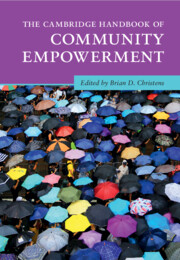Book contents
- The Cambridge Handbook of Community Empowerment
- Cambridge Handbooks in Psychology
- The Cambridge Handbook of Community Empowerment
- Copyright page
- Contents
- Figures
- Tables
- Contributors
- Building Community Power
- Part I Organizing and Activism
- Part II Participatory Governance
- Part III Civil Society and Coalitions
- Part IV Enterprise
- Part V Participatory and Community Arts
- 18 Participatory Arts for Vulnerable Populations
- 19 Community Arts, Decoloniality, and Epistemic Justice
- Part VI Education and Engaged Research
- Contributor Details
- Index
- References
18 - Participatory Arts for Vulnerable Populations
from Part V - Participatory and Community Arts
Published online by Cambridge University Press: 18 April 2024
- The Cambridge Handbook of Community Empowerment
- Cambridge Handbooks in Psychology
- The Cambridge Handbook of Community Empowerment
- Copyright page
- Contents
- Figures
- Tables
- Contributors
- Building Community Power
- Part I Organizing and Activism
- Part II Participatory Governance
- Part III Civil Society and Coalitions
- Part IV Enterprise
- Part V Participatory and Community Arts
- 18 Participatory Arts for Vulnerable Populations
- 19 Community Arts, Decoloniality, and Epistemic Justice
- Part VI Education and Engaged Research
- Contributor Details
- Index
- References
Summary
Participatory art, such as performing arts or visual arts, design, and craft, can be transformative in its ability to expose current systems of oppression while also providing a conceptual avenue for imagining and planning a different system. This chapter will describe how participatory arts may create a unique opportunity for youth empowerment and will discuss how participatory arts have the opportunity to address potential barriers to empowerment. With this chapter we aim to provide an overview of the empowerment process for youth with marginalized identities. We use a case example of a community-based program focused on drama therapy and theatrical performances, 2nd Act, to demonstrate how this type of participatory arts programming can be especially valuable for youth with additional vulnerabilities such as addiction and mental health recovery. Finally, we review how the literature on participatory arts using drama and theater demonstrates the capacity for these methods to enable broader community-level engagement and empowerment.
- Type
- Chapter
- Information
- The Cambridge Handbook of Community Empowerment , pp. 457 - 479Publisher: Cambridge University PressPrint publication year: 2024



